mirror MINI COOPER CONVERTIBLE 2009 Owners Manual
[x] Cancel search | Manufacturer: MINI, Model Year: 2009, Model line: COOPER CONVERTIBLE, Model: MINI COOPER CONVERTIBLE 2009Pages: 172, PDF Size: 2.73 MB
Page 12 of 172

Cockpit
10
Cockpit
Around the steering wheel: Controls and displays
1Adjusting the exterior mirrors, folding them
in and out
*38
2
Parking lamps73
Low beams73
Automatic headlamp control
*73
Turn signals47
High beams75
Headlamp flasher47
Roadside parking lamps
*75
Computer
*53
Page 40 of 172
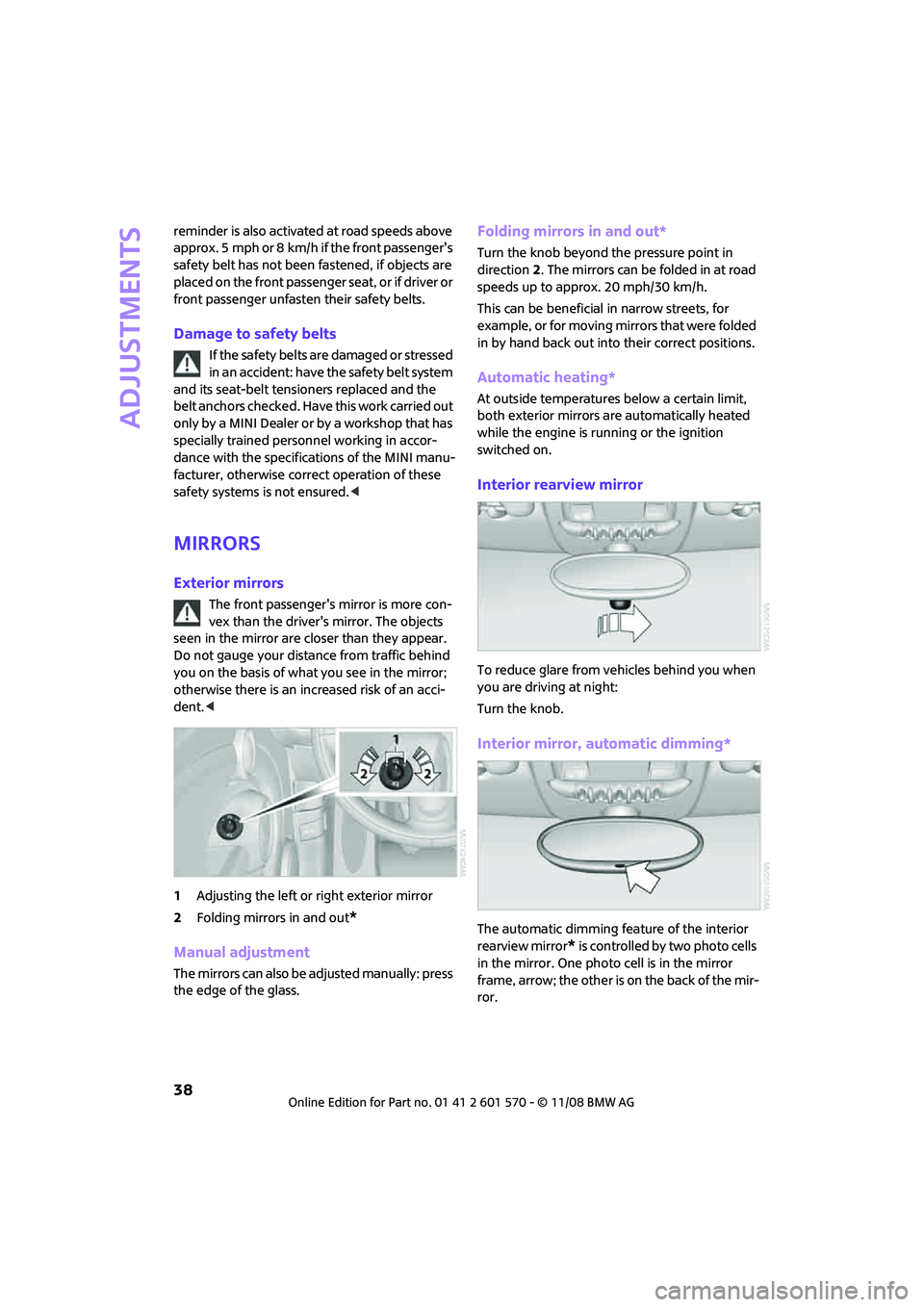
Adjustments
38
reminder is also activated at road speeds above
approx. 5 mph or 8 km/h if the front passenger's
safety belt has not been fastened, if objects are
placed on the front passenger seat, or if driver or
front passenger unfasten their safety belts.
Damage to safety belts
If the safety belts are damaged or stressed
in an accident: have the safety belt system
and its seat-belt tensioners replaced and the
belt anchors checked. Have this work carried out
only by a MINI Dealer or by a workshop that has
specially trained personnel working in accor-
dance with the specifications of the MINI manu-
facturer, otherwise correct operation of these
safety systems is not ensured.<
Mirrors
Exterior mirrors
The front passenger's mirror is more con-
vex than the driver's mirror. The objects
seen in the mirror are closer than they appear.
Do not gauge your distance from traffic behind
you on the basis of what you see in the mirror;
otherwise there is an increased risk of an acci-
dent.<
1Adjusting the left or right exterior mirror
2Folding mirrors in and out
*
Manual adjustment
The mirrors can also be adjusted manually: press
the edge of the glass.
Folding mirrors in and out*
Turn the knob beyond the pressure point in
direction 2. The mirrors can be folded in at road
speeds up to approx. 20 mph/30 km/h.
This can be beneficial in narrow streets, for
example, or for moving mirrors that were folded
in by hand back out into their correct positions.
Automatic heating*
At outside temperatures below a certain limit,
both exterior mirrors are automatically heated
while the engine is running or the ignition
switched on.
Interior rearview mirror
To reduce glare from vehicles behind you when
you are driving at night:
Turn the knob.
Interior mirror, automatic dimming*
The automatic dimming feature of the interior
rearview mirror
* is controlled by two photo cells
in the mirror. One photo cell is in the mirror
fr a m e , a r r o w ; t h e o t h e r i s o n t h e b a c k o f t h e m ir -
ror.
Page 41 of 172
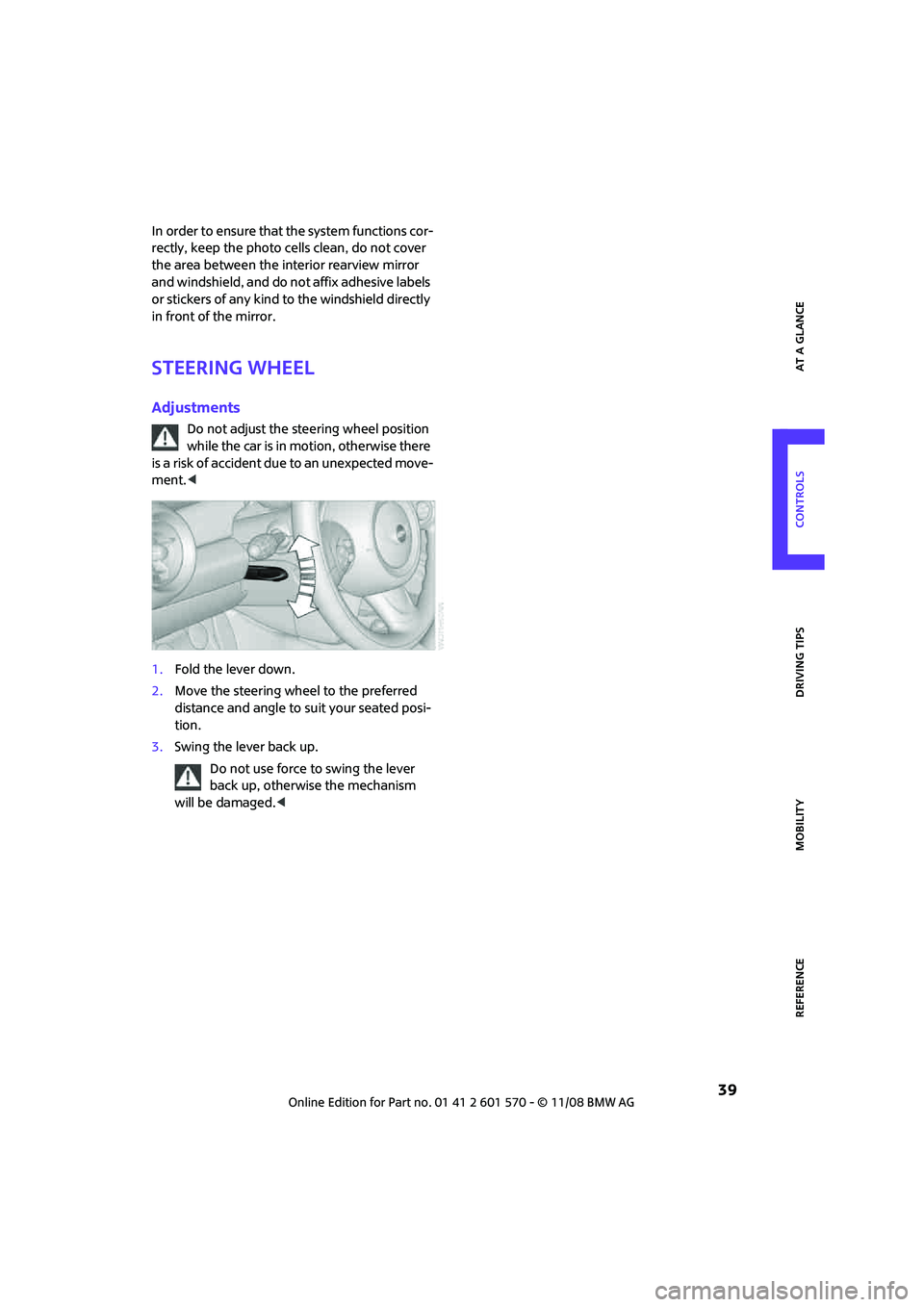
REFERENCEAT A GLANCE CONTROLS DRIVING TIPS MOBILITY
39
In order to ensure that the system functions cor-
rectly, keep the photo cells clean, do not cover
the area between the interior rearview mirror
and windshield, and do not affix adhesive labels
or stickers of any kind to the windshield directly
in front of the mirror.
Steering wheel
Adjustments
Do not adjust the steering wheel position
while the car is in motion, otherwise there
is a risk of accident due to an unexpected move-
ment.<
1.Fold the lever down.
2.Move the steering wheel to the preferred
distance and angle to suit your seated posi-
tion.
3.Swing the lever back up.
Do not use force to swing the lever
back up, otherwise the mechanism
will be damaged.<
Page 51 of 172

REFERENCEAT A GLANCE CONTROLS DRIVING TIPS MOBILITY
49
Intermittent wipe or rain sensor*
If the car is not equipped with a rain sensor, the
intermittent-wipe time is preset.
If the car is equipped with a rain sensor, the time
between wipes is controlled automatically and
depends on the intensity of the rainfall. The rain
sensor is mounted on the windshield, directly in
front of the interior rearview mirror.
Activating intermittent wipe or rain
sensor
Press button, arrow3.
Deactivate the rain sensor before entering
an automatic car wash. Failure to do so
could result in damage caused by undesired
wiper activation.<
Adjusting the sensitivity of the rain
sensor
1.Switch on the ignition, refer to page43.
2.Briefly press the button in the turn indicator
lever repeatedly until "SET/INFO" is dis-
played.
3.Press and hold the button until the display
changes.
4.Briefly press the button repeatedly until the
symbol and "SET" are displayed.5.Press and hold the button until the display
changes.
6.Press the button to select the desired sensi-
tivity.
7.Wait, or press and hold the button until the
display changes.
The settings are stored.
Deactivating intermittent wipe or rain
sensor
Press the button again, arrow3.
Brief wipe
Press the lever downward once, arrow2.
Cleaning windshield and headlamps*
Pull the lever, arrow 4.
Washer fluid is sprayed onto the windshield and
the wipers are operated briefly.
When the vehicle lighting system is switched on,
the headlamps are cleaned at regular and
appropriate intervals.
In cars equipped with an alarm system, the
headlamps cannot be cleaned when the bonnet
is open.
Do not use the washers when the washer
fluid reservoir is empty, otherwise you will
damage the washer pump.
Only use the washers if the bonnet has been
completely closed, otherwise the headlamp
washer system
* may be damaged. Do not use
the washers if there is any danger that the fluid
will freeze on the windshield. If you do, your
vision could be obscured. For this reason, use
antifreeze.<
Page 73 of 172
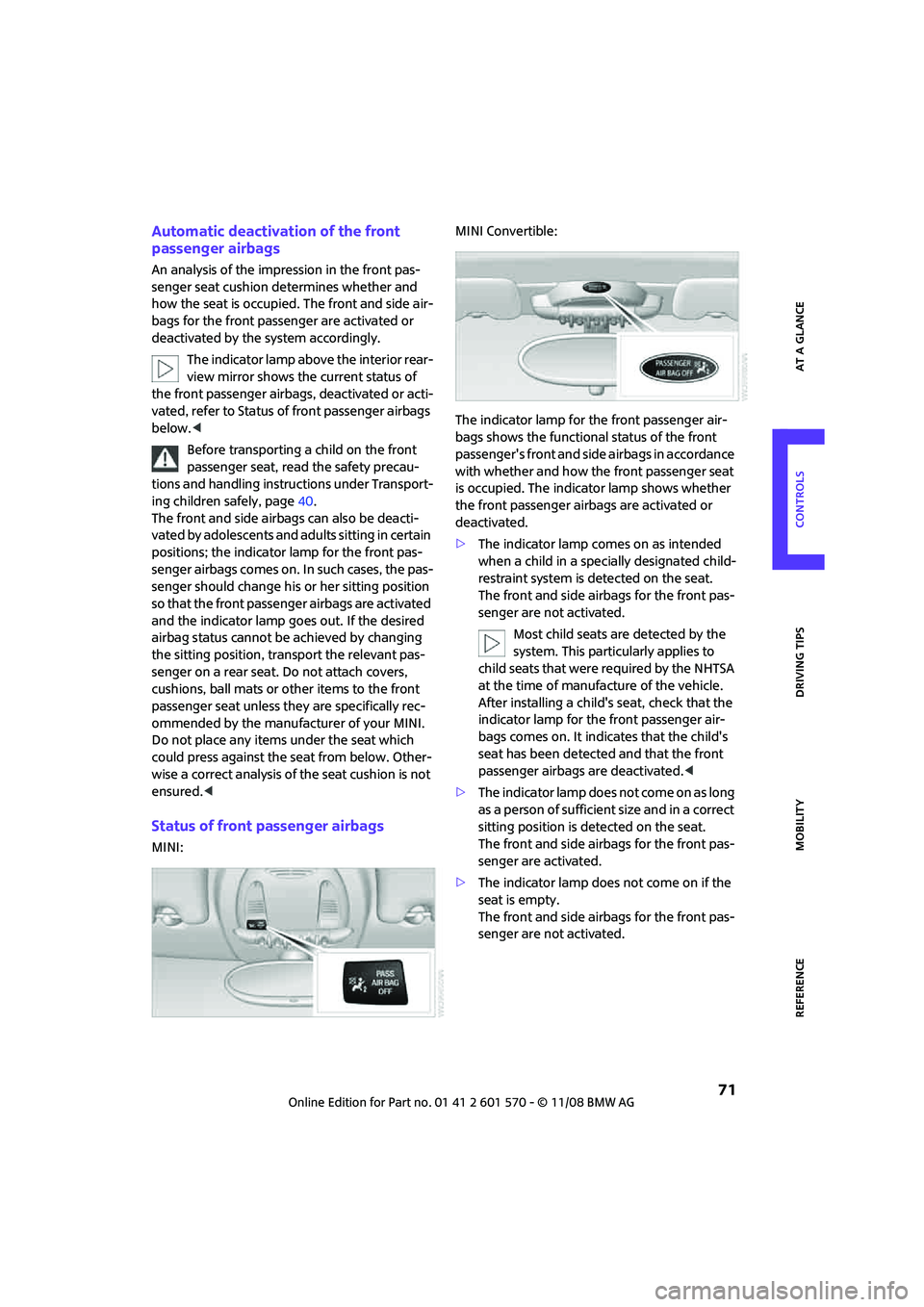
REFERENCEAT A GLANCE CONTROLS DRIVING TIPS MOBILITY
71
Automatic deactivation of the front
passenger airbags
An analysis of the impression in the front pas-
senger seat cushion determines whether and
how the seat is occupied. The front and side air-
bags for the front passenger are activated or
deactivated by the system accordingly.
The indicator lamp above the interior rear-
view mirror shows the current status of
the front passenger airbags, deactivated or acti-
vated, refer to Status of front passenger airbags
below.<
Before transporting a child on the front
passenger seat, read the safety precau-
tions and handling instructions under Transport-
ing children safely, page40.
The front and side airbags can also be deacti-
vated by adolescents and adults sitting in certain
positions; the indicator lamp for the front pas-
senger airbags comes on. In such cases, the pas-
senger should change his or her sitting position
so that the front passenger airbags are activated
and the indicator lamp goes out. If the desired
airbag status cannot be achieved by changing
the sitting position, transport the relevant pas-
senger on a rear seat. Do not attach covers,
cushions, ball mats or other items to the front
passenger seat unless they are specifically rec-
ommended by the manufacturer of your MINI.
Do not place any items under the seat which
could press against the seat from below. Other-
wise a correct analysis of the seat cushion is not
ensured.<
Status of front passenger airbags
MINI:MINI Convertible:
The indicator lamp for the front passenger air-
bags shows the functional status of the front
passenger's front and side airbags in accordance
with whether and how the front passenger seat
is occupied. The indicator lamp shows whether
the front passenger airbags are activated or
deactivated.
>The indicator lamp comes on as intended
when a child in a specially designated child-
restraint system is detected on the seat.
The front and side airbags for the front pas-
senger are not activated.
Most child seats are detected by the
system. This particularly applies to
child seats that were required by the NHTSA
at the time of manufacture of the vehicle.
After installing a child's seat, check that the
indicator lamp for the front passenger air-
bags comes on. It indicates that the child's
seat has been detected and that the front
passenger airbags are deactivated.<
>T h e i n d i c a t o r l a m p d o e s n o t c o m e o n a s l o n g
as a person of sufficient size and in a correct
sitting position is detected on the seat.
The front and side airbags for the front pas-
senger are activated.
>The indicator lamp does not come on if the
seat is empty.
The front and side airbags for the front pas-
senger are not activated.
Page 98 of 172
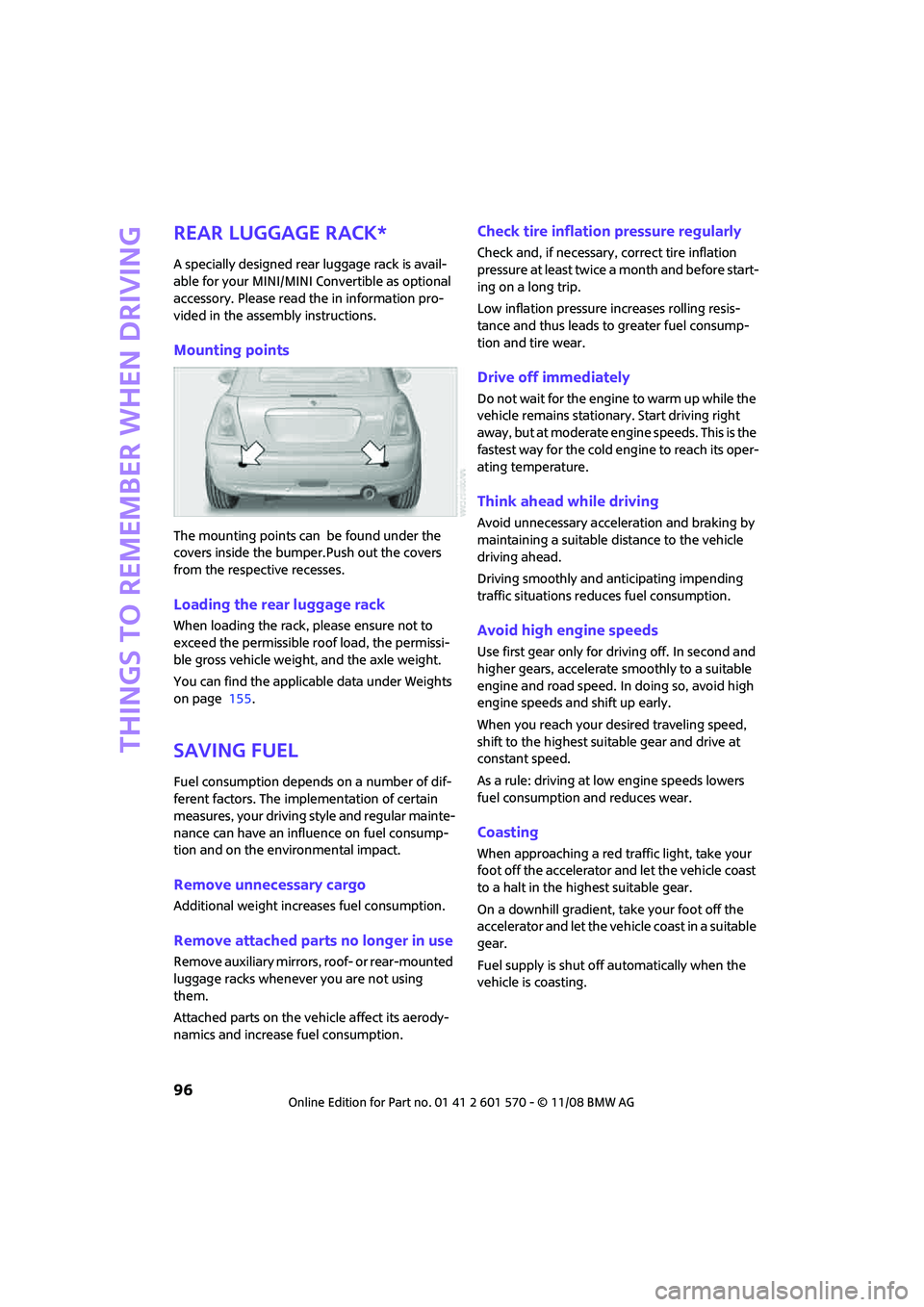
Things to remember when driving
96
Rear luggage rack*
A specially designed rear luggage rack is avail-
able for your MINI/MINI Convertible as optional
accessory. Please read the in information pro-
vided in the assembly instructions.
Mounting points
The mounting points can be found under the
covers inside the bumper.Push out the covers
from the respective recesses.
Loading the rear luggage rack
When loading the rack, please ensure not to
exceed the permissible roof load, the permissi-
ble gross vehicle weight, and the axle weight.
You can find the applicable data under Weights
on page 155.
Saving fuel
Fuel consumption depends on a number of dif-
ferent factors. The implementation of certain
measures, your driving style and regular mainte-
nance can have an influence on fuel consump-
tion and on the environmental impact.
Remove unnecessary cargo
Additional weight increases fuel consumption.
Remove attached parts no longer in use
Remove auxiliary mirrors, roof- or rear-mounted
luggage racks whenever you are not using
them.
Attached parts on the vehicle affect its aerody-
namics and increase fuel consumption.
Check tire inflation pressure regularly
Check and, if necessary, correct tire inflation
pressure at least twice a month and before start-
ing on a long trip.
Low inflation pressure increases rolling resis-
tance and thus leads to greater fuel consump-
tion and tire wear.
Drive off immediately
Do not wait for the engine to warm up while the
vehicle remains stationary. Start driving right
away, but at moderate engine speeds. This is the
fastest way for the cold engine to reach its oper-
ating temperature.
Think ahead while driving
Avoid unnecessary acceleration and braking by
maintaining a suitable distance to the vehicle
driving ahead.
Driving smoothly and anticipating impending
traffic situations reduces fuel consumption.
Avoid high engine speeds
Use first gear only for driving off. In second and
higher gears, accelerate smoothly to a suitable
engine and road speed. In doing so, avoid high
engine speeds and shift up early.
When you reach your desired traveling speed,
shift to the highest suitable gear and drive at
constant speed.
As a rule: driving at low engine speeds lowers
fuel consumption and reduces wear.
Coasting
When approaching a red traffic light, take your
foot off the accelerator and let the vehicle coast
to a halt in the highest suitable gear.
On a downhill gradient, take your foot off the
accelerator and let the vehicle coast in a suitable
gear.
Fuel supply is shut off automatically when the
vehicle is coasting.
Page 121 of 172

REFERENCEAT A GLANCE CONTROLS DRIVING TIPS MOBILITY
119
Care
Car-care products
Regular cleaning and care helps to maintain the
value of your MINI.
The manufacturer of your MINI recommends
using manufacturer-approved products to clean
and care for your vehicle.
MINI Service would be pleased to advise you on
cleaning and care products and services for your
MINI.
The ingredients of original MINI CareProd-
ucts have been tested, and the products
have been tested in the laboratory and in prac-
tice. They offer optimum care and protection for
your vehicle.<
Do not use any cleansers containing alco-
hol or solvents as these may cause dam-
age.<
Cleaning agents may contain hazardous
or health-damaging substances. Follow
the warning and hazard instructions on the
packaging. For interior cleaning, always open
the doors or windows of the vehicle.
Do not use any products that are not intended
for cleaning the vehicle.<
External care
Washing your vehicle
Especially during the winter months the
vehicle should be frequently washed. Dirt
and road salt can damage the vehicle.<
After washing the vehicle, apply the
brakes briefly to dry them, otherwise
water can reduce braking efficiency over the
short term and the brake rotors can corrode.<
Car washes
Avoid car washes with tracks higher than
4 in/10 cm, otherwise the chassis could be
damaged.<
Preference should be given to cloth car washes.
Do not use high-pressure car washes
because drops of water can penetrate
around the windows.<
Before driving into the car wash, check if the sys-
tem is suitable for your MINI. Observe the fol-
lowing points:
>Dimensions of the vehicle, page153.
>If necessary: Fold in the outside mirrors,
page 38.
>Maximum permissible tire width.
Preparations for driving into the car wash:
>Unscrew the rod antenna.
>Deactivate the rain sensor
* to prevent unin-
tentional wiping.
>Deactivate the rear windshield wiper and
protect it from damage. Ask the car wash
operator about measures that can be taken
to protect the wipers.
>Remove additional detachable body com-
ponents such as spoilers or telephone
antennas that could be damaged.
Automatic transmission
Before driving into the car wash, make sure that
the vehicle can roll:
1.Place the remote control, even with conve-
nient access, in the ignition lock.
2.Move the selector lever to position N.
3.Release the parking brake.
4.Switch off the engine.
5.Insert the remote control in the ignition lock
so that the vehicle can roll.
Page 122 of 172

Care
120
Steam jets/high-pressure washers
When using steam jets or high-pressure
washers, ensure that you maintain a suffi-
cient distance to the vehicle and do not exceed a
maximum temperature of 1407/606.
If the distance is too close, the pressure too high,
or the temperature too high, parts of the vehicle
can be damaged, or water can penetrate.
Observe the operating instructions for high-
pressure washers.<
Do not spray sensors such as Park Dis-
tance Control with high-pressure washers
for a long time or at a distance of less than
1 ft/30 cm.<
Manual washing
Use a great deal of water and, if necessary, car
shampoo when washing your car by hand. Clean
the vehicle with a sponge or a washing brush
applying a slight amount of pressure.
Before cleaning the windshield, deacti-
vate the rain sensor or turn off the ignition
to prevent unintentional wiping.<
Observe local regulations regarding wash-
ing vehicles by hand.<
Headlamps
Do not wipe dry and do not use abrasive or cor-
rosive cleaning agents. Remove dirt and con-
tamination, such as insects, by soaking with
shampoo and then washing with plenty of
water.
Do not remove accumulated ice and snow with
an ice scraper; use window de-icers instead.
Windows
Clean the outside and inside of the windows and
mirrors with a window cleaner.
Do not clean the mirrors with cleaners
containing quartz.<
Wiper blades
Clean with soapy water and change regularly to
prevent the formation of streaksWax, preservatives and dirt on the win-
dows cause streaks when the windshield
wipers are on, and can cause premature wear of
the wiper blades and interfere with the rain sen-
sor.<
Care of the convertible top
The appearance and service life of the convert-
ible top largely depends on its proper care and
operation.
Please follow these instructions:
>Never attempt to fold and stow the convert-
ible top in the convertible compartment
when the top is wet or frozen. Otherwise
water stains, mildew, and chafe marks may
occur.
>Should water stains still appear on the head-
lining, use a microfibre cloth and interior
cleaning solution to remove them.
>If the vehicle is parked in an enclosed area
for a longer period of time, make sure that
there is sufficient ventilation.
>Remove any bird droppings immediately,
since they have corrosive properties which
will corrode the convertible top and damage
the rubber seals.
When attempting to remove stains from
the convertible top, do not use spot
removers, paint thinners, solvents, gasoline, or
similar fluids. These cleaners may damage the
rubber seals. The improper care or cleaning
methods may cause the convertible top and its
seams to leak.<
Use special convertible top cleaning agents if
attempting to remove heavy stains.
Always read and follow the manufacturer's
instructions.
Use an impregnating agent to treat the convert-
ible top once a year.
Paintwork, care
Regular care maintains the vehicle's value and
protects the paint from the long-term effects of
paint-damaging substances.
Page 163 of 172
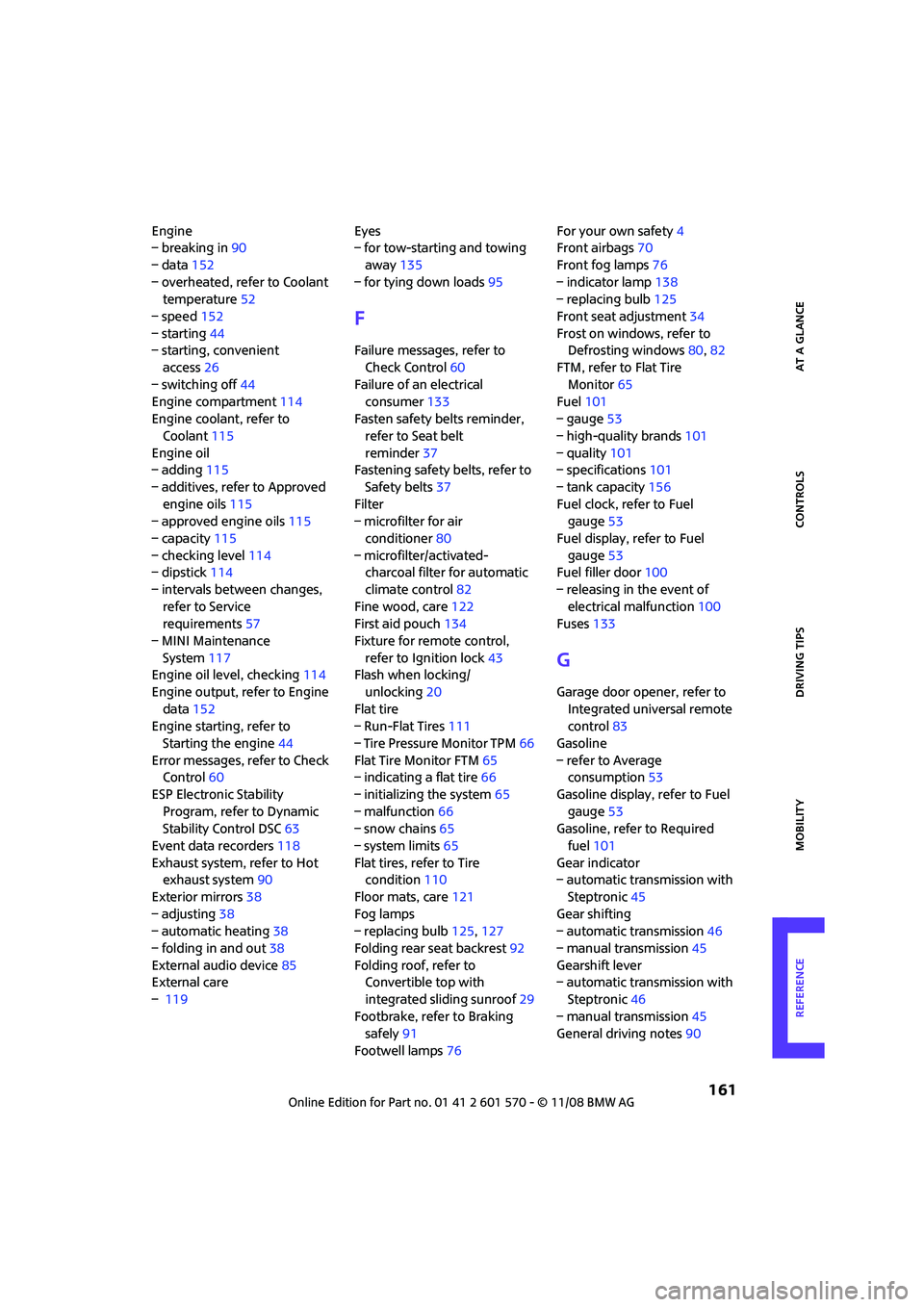
REFERENCEAT A GLANCE CONTROLS DRIVING TIPS MOBILITY
161
Engine
– breaking in90
– data152
– overheated, refer to Coolant
temperature52
– speed152
– starting44
– starting, convenient
access26
– switching off44
Engine compartment114
Engine coolant, refer to
Coolant115
Engine oil
– adding115
– additives, refer to Approved
engine oils115
– approved engine oils115
– capacity115
– checking level114
– dipstick114
– intervals between changes,
refer to Service
requirements57
– MINI Maintenance
System117
Engine oil level, checking114
Engine output, refer to Engine
data152
Engine starting, refer to
Starting the engine44
Error messages, refer to Check
Control60
ESP Electronic Stability
Program, refer to Dynamic
Stability Control DSC63
Event data recorders118
Exhaust system, refer to Hot
exhaust system90
Exterior mirrors38
– adjusting38
– automatic heating38
– folding in and out38
External audio device85
External care
– 119Eyes
– for tow-starting and towing
away135
– for tying down loads95
F
Failure messages, refer to
Check Control60
Failure of an electrical
consumer133
Fasten safety belts reminder,
refer to Seat belt
reminder37
Fastening safety belts, refer to
Safety belts37
Filter
– microfilter for air
conditioner80
– microfilter/activated-
charcoal filter for automatic
climate control82
Fine wood, care122
First aid pouch134
Fixture for remote control,
refer to Ignition lock43
Flash when locking/
unlocking20
Flat tire
– Run-Flat Tires111
– Tire Pressure Monitor TPM66
Flat Tire Monitor FTM65
– indicating a flat tire66
– initializing the system65
– malfunction66
– snow chains65
– system limits65
Flat tires, refer to Tire
condition110
Floor mats, care121
Fog lamps
– replacing bulb125,127
Folding rear seat backrest92
Folding roof, refer to
Convertible top with
integrated sliding sunroof29
Footbrake, refer to Braking
safely91
Footwell lamps76For your own safety4
Front airbags70
Front fog lamps76
– indicator lamp138
– replacing bulb125
Front seat adjustment34
Frost on windows, refer to
Defrosting windows80,82
FTM, refer to Flat Tire
Monitor65
Fuel101
– gauge53
– high-quality brands101
– quality101
– specifications101
– tank capacity
156
Fuel clock, refer to Fuel
gauge53
Fuel display, refer to Fuel
gauge53
Fuel filler door100
– releasing in the event of
electrical malfunction100
Fuses133
G
Garage door opener, refer to
Integrated universal remote
control83
Gasoline
– refer to Average
consumption53
Gasoline display, refer to Fuel
gauge53
Gasoline, refer to Required
fuel101
Gear indicator
– automatic transmission with
Steptronic45
Gear shifting
– automatic transmission46
– manual transmission45
Gearshift lever
– automatic transmission with
Steptronic46
– manual transmission45
General driving notes90
Page 164 of 172

From A to Z
162
Glass sunroof, electric27
– convenient operation20,22
– opening, closing28
– raising28
– remote control20
Glove compartment85
Grills, refer to Air vents78
Gross vehicle weight, refer to
Weights155
H
Halogen lamps
– replacing bulb124
Handbrake, refer to Parking
brake45
Hands-free system14
Hazard warning flashers14
Head airbags70
Head restraints36
– sitting safely34
Headlamp control,
automatic73
Headlamp flasher47
– indicator lamp11,138
Headlamps
– replacing bulb124
Headlamps, care120
Heated
– mirrors38
– rear window79,82
– seats37
Heating78
– mirrors38
– rear window79,82
– seats37
Heavy loads, refer to Stowing
cargo94
Height adjustment
– seats35
– steering wheel39
Height, refer to
Dimensions153
High beams75
– headlamp flasher75
– indicator lamp138
– replacing bulb124
High water, refer to Driving
through water91Hill Start Assist64
Hills91
Holders for cups87
Homepage4
Horn10
Hot exhaust system90
Hydroplaning90
I
Ice warning52
Icy roads, refer to Outside
temperature warning52
Ignition43
– switched off43
– switched on43
Ignition key position 1, refer to
Radio readiness43
Ignition key position 2, refer to
Ignition on43
Ignition key, refer to
Integrated key/remote
control18
Ignition lock43
Imprint2
Indicator and warning
lamps13,138
– Tire Pressure Monitor TPM67
Indicator lighting, refer to
Instrument lighting76
Individual air distribution80
Individual settings, refer to
Personal Profile18
Inflation pressure monitoring,
refer to Tire Pressure Monitor
TPM66
Initializing
– Flat Tire Monitor FTM65
– glass sunroof, electric28
Instrument cluster, refer to
Displays12
Instrument lighting76
Instrument panel, refer to
Cockpit10
Instrument panel, refer to
Displays12
Integrated key18
Integrated universal remove
control83Interior lamps76
– remote control21
Interior rearview mirror38
– automatic dimming
feature38
Interlock46
Intermittent mode of the
wipers48
Internet page4J
Jacking points131
Jets, refer to Window washer
nozzles50
Jump starting134
Jumpering, refer to Jump
starting134
K
Key Memory, refer to Personal
Profile18
Key, refer to Keys/remote
controls18
Keyless go, refer to Convenient
access26
Keyless opening and closing,
refer to Convenient
access26
Kick-down46
– automatic transmission with
Steptronic46
Knock control101
L
Lamps and bulbs, replacing
bulbs123
Lamps, refer to Parking lamps/
Low beams73
Lashing eyes, refer to Securing
cargo95
LATCH child-restraint fixing
system41
Leather care121
LEDs light-emitting diodes124
Length, refer to
Dimensions153